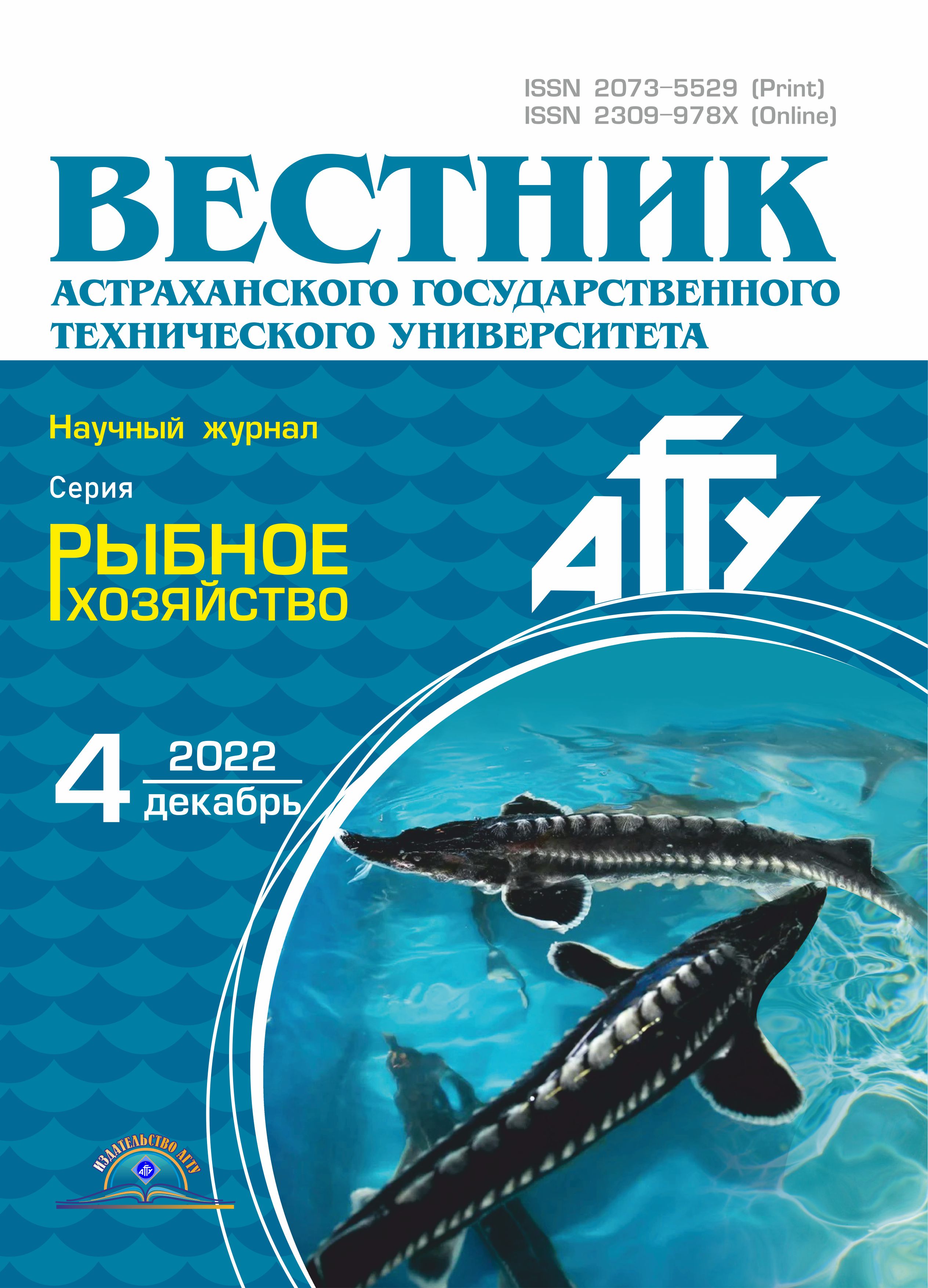Россия
В рамках изучения современного состояния рыб и условий их обитания в прибрежной зоне г. Севастополя был проанализирован комплекс параметров различного уровня организации вида-монитора – чер-номорской скорпены. Несмотря на сходство в значениях размера и массы у рыб из разных бухт можно обнаружить такую закономерность в их величинах: б. Балаклавская > б. Круглая > б. Стрелецкая. Индексы жабр и печени Scorpaena porcus из бухты Стрелецкой были выше у рыб старшей группы по сравнению с другими акваториями, что рассматривалось как адаптивная реакция на неблагополучные условия обитания. В то же время высокие значения индекса печени, размеров и массы рыб, содержания глюкозы в крови у этого донного вида из Балаклавской бухты свидетельствовали о более качественной естественной кормовой базе рыб. Таким образом, значения изучаемых параметров у рыб из разных бухт часто отличались незначительно, что свидетельствует о сходстве условий обитания в современный период и удовлетворительном состоянии бухт Севастополя. Об этом свидетельствовали и данные анализа морфометрических параметров жабр: длина и ширина филаментов, а также плотность их распределения на жаберной дуге достоверно не различались у одноразмерных представителей из разных бухт. Однако при сравнении межгодовых изменений популяционных параметров было установлено, что по сравнению с 2017–2019 гг. размер скорпены, особенно самок, снизился. Масса уменьшилась у рыб из б. Балаклавской на 8–10 г, у особей из б. Круглой – на 20 г, а ерш из б. Стрелецкой в 2021 г. имел вес почти вдвое меньше, чем в предыдущие годы. Проведенные биоиндикационные исследования свидетельствуют об ухудшении экологического статуса изученных акваторий Крыма.
скорпена, Scorpaena porcus, загрязнение, уровень глюкозы в крови, печень, сердце, селезенка, жабры, размер и вес рыбы
Introduction
Years of research on the state of fish using the set of biological parameters is an informative approach to conduct biomonitoring of various parts of an ecosystem [1]. In our opinion, many physiological parameters can reflect sensitivity (a response to changes) of bioindicators of various levels of organism organization. When an animal is taken out of its natural environment, researchers’ first action is to estimate main population parameters which show the impact of prolonged exposure to the environment. Physiological and morphological parameters “speak” about the state of an organism which experiences not only prolonged (for weeks, months) exposure to the environment but also is affected by short-term natural and anthropogenic factors. Biochemical indicators are more responsive to rapid changes in the environment itself [1] and to processes in which a specimen itself is involved (feeding, reproduction, etc.).
The way fish respond (most of their responses) makes them ideal subjects for observation, and analysis of fish has become a popular approach to detect changes in the aquatic environment.
The results of scientific observation of the monitor species - Black Sea scorpion fish Scorpaena porcus – gave comprehensive information about the physiological state of this species and the status of the bays – areas where fish were caught [2]. The present work is aimed at studying the current state of the Black Sea scorpion fish using the set of parameters of various levels of organism organization.
Маtherials and methods
The research subject is the sea scorpion fish, Scorpaena porcus Linnaeus, 1758. This fish species has
a tall body with a large head covered with numerous spines and dermal excrescence [3]. As for its body colour, it has a reddish-brown hue. Scorpaena inhabits the eastern Atlantic- from the British Isles to Morocco, the Azores and in the Mediterranean Basin. In the Black Sea, it is widespread along the entire coast, can also be found in the Kerch Strait and the Sea of Azov. It spawns mainly in May and June, although the full spawning period lasts from April to mid-September.
This species does not have a high commercial value, but it is a favoured one by hobby-fisheremen [3, 4].
During the spring-summer 2021, we conducted
a study of some parameters of the Black Sea scorpion fish captured using seines in the following bays of Sevastopol: Kruglaya, Streletskaya and Balaklavskaya (Fig. 1).
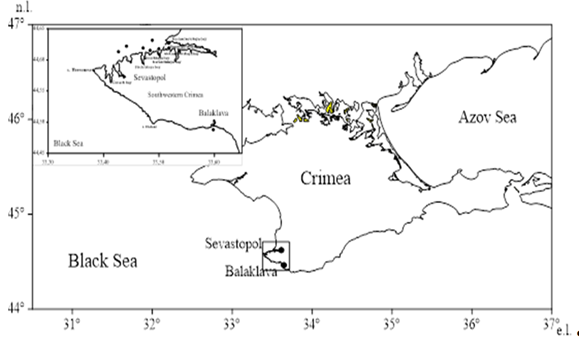
Fig. 1. Scheme of the study area and location of sampling points
For the period May-June 2021, we analyzed the blood glucose levels in fish caught in the bays of Sevastopol. Live specimens caught in the morning
(6 : 00 a.m. – 7 : 00 a.m.) were placed in a bucket for
1-1.5 hours where fish could adapt due to aeration. The specimens of the scorpion fish were then quickly pulled out of the water and each of them was punctured in the caudal artery. We then brought the edge of the reagent paper to the hole and gently soaked it with blood oozing from the artery. An “Accu-Chek Active” glucometer (Germany) was used to determine the concentration
of glucose in the blood. 140 fish were treated according to the above technique to study this parameter.
Further analysis of the fish was conducted in the IBSS laboratory. The bioanalysis included length measurement (Tl-total and Sl-standart lenght), a procedure of weighing fish and soma and weghing gills, liver, gonads, heart and spleen. We also determined the sex of the scorpion and the stage of maturation
of the reproductive products; age of the fish was determined by reading otholits. 325 specimens of S. porcus were analysed to draw conclusions from our data on morphophysiological and population parameters.
The indexes of gills, heart, spleen were calculated based on the formula organ weight ∙ 100% / fish soma weight (%).
Hepatosomatic index was calculated based on the formula: organ weight ∙ 1000 / soma weight (‰).
The morphometric characteristics of the gills:
N – density of gill filament (numbers), a – length
of filament (mm), b – width of filament (mm) were determined by analogy with our previous studies [5].
To perform statistical analysis of all the morphophysiological, biochemical and population parameters, we sorted the specimens by sex, age and habitat area. The data obtained were processed and the graphs were constructed using EXCEL 2016 software.
Results
As for size and weight of S. porcus, their values are about the same for fish from different bays in coastal waters of Sevastopol, however, we can rank the following bays in order of decreasing size and weight
of fish from them: Balaklavskaya – Kruglaya – Streletskaya (Table 1).
Тable 1
Size and weight, gill index of scorpion fish from different bays of Sevastopol in 2021
(in numerator – for female, in denominator – for male)
|
Bays |
Age, y.o. Parameter |
4 |
5 |
6 |
7 |
|
Strelezkaya |
Tl, сm |
12.6 ± 0.7 12.3 ± 0.5 |
13.5 ± 0.5 13.9 ± 0.5 |
18.4 ± 1.9 15.2 ± 0.2 |
17.2 ± 0.7 – |
|
Sl, сm |
9.9 ± 0.7 9.8 ± 0.4 |
10.7 ± 0.4 10.9 ± 4.3 |
14.6 ± 1.7 12.2 ± 0.2 |
13.7 ± 0.6 – |
|
|
Fish weight, g |
40.9 ± 8.5 31.1 ± 3.7 |
42.98 ± 4.9 43.4 ± 4.3 |
131.05 ± 45.5 62.4 ± 5.1 |
104.2 ± 12.6 – |
|
|
Gill index, % |
4.5 ± 0.2 4.1 ± 0.1 |
4.4 ± 0.2 4.4 ± 0.1 |
5.0 ± 0.4 4.3 ± 0.2 |
5.0 ± 0.3 – |
|
|
Kruglaya |
Tl, сm |
13.6 ± 0.6* – |
14.6 ± 1.2 – |
16.0 ± 0.6 15.4 ± 0.4 |
18.3 ± 0.7 15.9 ± 0.6 |
|
Sl, сm |
10.8 ± 0.5 – |
11.6 ± 0.9 – |
12.7 ± 0.5 12.3 ± 0.3 |
14.7 ± 0.5 12.7 ± 0.5 |
|
|
Fish weight, g |
46.1 ± 7.3 – |
76.09 ± 16.5 – |
77.7 ± 11.4 63.5 ± 4.6 |
128.3 ± 15.4 66.4 ± 6.9 |
|
|
Gill index, % |
4.1 ± 0.1 – |
4.5 ± 0.1 – |
3.9 ± 0.7 4.6 ± 0.1 |
4.4 ± 0.2 4.6 ± 0.2 |
|
|
Balaklavskaya |
Tl, cm |
– |
15.4 ± 0.6 15.8 ± 0.7 |
17.3 ± 0.5 16.8 ± 0.8 |
19.4 ± 1.3 17.8 ± 1.1 |
|
Sl, cm |
– |
12.2 ± 0.6 12.5 ± 0.6 |
13.8 ± 0.4 13.5 ± 0.6 |
15.7 ± 1.03 14.2 ± 0.9 |
|
|
Fish weight, g |
– |
71.9 ± 10.8 80.5 ± 10.4 |
113.8 ± 12.7 103.4 ± 15.2 |
186.3 ± 44.9 120.2 ± 25.9 |
|
|
Gill index, % |
– |
4.8 ± 0.2 4.7 ± 0.2 |
4.0 ± 0.3 4.4 ± 0.1 |
4.1 ± 0.3 4.5 ± 0.3 |
* Single individuals or their absence.
Comparative analysis did not show a significant difference in gill index between fish of different age from all the mentioned water areas (Table 1). The highest values of this parameter were registered among 6- and 7-year-old females from Streletskaya Bay
(5.05 ± 0.32% in 7-year-old specimens).
Interestingly, morphometric characteristics of the gills such as length and width of filaments, and density of filament distribution on the gill arch did not differ significantly from specimen to specimen in the group we selected for that analysis (Fig. 2).
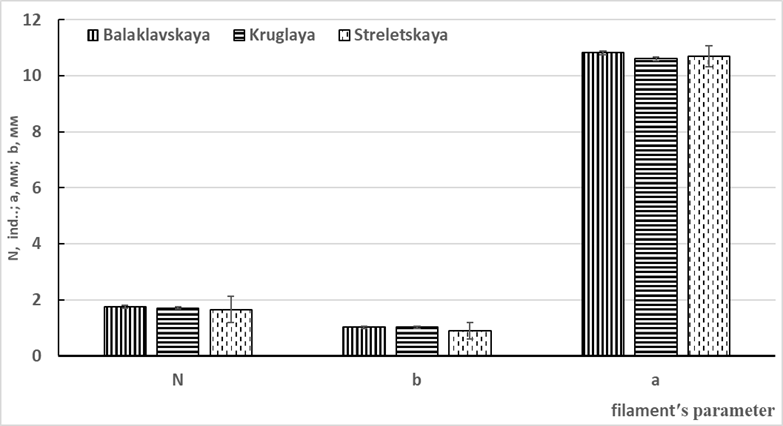
Fig. 2. Morphometric parameters of gills of scorpion fish from different Sevastopol bays in 2021:
N – density of gill filament, number; a – length of filament, mm; b – width of filament, mm
This was the largest sample group consisting
of 6- to 7-year-old females of similar size (Tl 18.1–25.2 cm, and Sl 14.0–20.2 cm) from the three bays.
It was previously found that integrated pollution
of the bays of Sevastopol led to a decrease in the spleen index for most fish species of the Black Sea [6]. In addition, no significant difference was registered between the values of this index in fish of different sexes [6]. For that reason, in the present work, the data obtained have been broken down into groups by age and habitat area. This breakdown of the data revealed that the spleen index was markedly lower in 7-year-old females from Streletskaya Bay (0.05 ± 0.004%). In age and sex
of fish, their habitat and the fact of change in the index values, there is an analogy between the data on the gill index and spleen index: both of these indexes changed in 7-year-old females from Streletskaya Bay, and both reflect the response of fish to deteriorating environmental conditions. There was no significant difference between the spleen index values in other groups (‘age-bay’ combinations) (Fig. 3).

Fig. 3. Spleen index of scorpion fish from different Sevastopol bays in 2021
This year, similar results have been obtained when studying this index. In most cases, the heart index was lower for the scorpion fish from Kruglya and Streletskaya bays (Fig. 4).
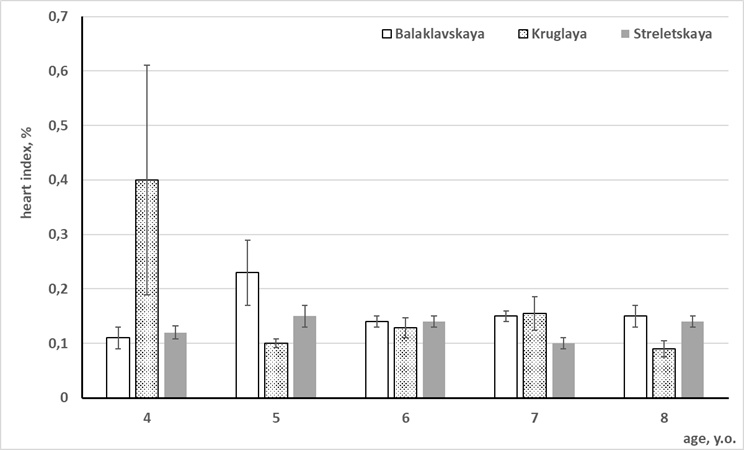
Fig. 4. Heart index of scorpion fish from different Sevastopol bays in 2021
Taking all three bays together, the highest hepatosomatic index values were registered in Scorpaena porcus fish from Balaklavskaya Bay, which is true for both males and females in each age group (Fig. 5).
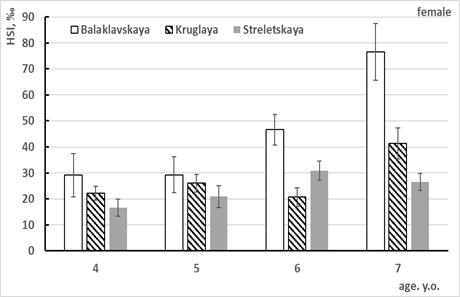
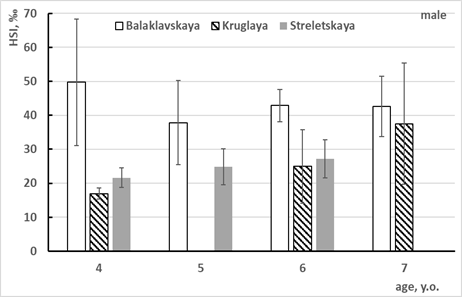
Fig. 5. Hepatosomatic index of Black Sea scorpion fish from different bays of Sevastopol in 2021:
a – female; b – male
In the period May-June 2021, we analyzed blood glucose levels in fish caught in the bays of Sevastopol. The blood glucose level in scorpion fish from Streletskaya Bay was significantly lower than those in other water areas (Table 2).
Table 2
Blood glucose levels of scorpion fish from the bays with different ecological conditions
|
Sex/age |
Bays |
||
|
Balaklavskaya |
Kruglaya |
Streletskaya |
|
|
Females (6-7-year-olds ) |
2.44 ± 0.33 |
4.52 ± 0.7 |
1.37 ± 0.24 |
|
Males (6-year-olds) |
7.53 ± 3.64 |
– |
2.46 ± 0.68 |
|
Males (7-year-olds) |
7.6 ± 2.38 |
1.63 ± 0.34 |
– |
Nevertheless, among equally aged female fish, the highest blood glucose level was registered in females from Kruglaya Bay, and in males from the same bay – the lowest level.
Discussion
Compared to the size of the scorpion fish in
2017–2019 [7] this species, especially females, has become smaller (4- and 5-year-olds were taken for comparison). “Loss” of weight in fish from Balaklavskaya Bay was 8–10 g, in specimens from Kruglaya Bay – 20 g, and for specimens of S. porcus caught from Streletskaya Bay in 2021 weight loss was almost half of the weight recorded in previous years.
Сhanges in the weight of fish organs depend, to
a greater extent, on various environmental factors and the physiological state of specimens, and this leads to organ index fluctuations, which has been reflected in academic literature and our research [8, 9].
There is some evidence that heart index of different species of the Black Sea ichthyofauna depends on which ecological group they belong to. There was no difference in the values of heart index between fish, including the scorpion fish, of different sexes; a relatioship between changes in heart index and age of fish has been found: it decreases with age. It is also known that heart index is an indicator reflecting the response of fish to pollution of different origins which can occur in coastal waters, but this response is mixed [8], as we saw in the course of the year 2021.
We suggest that the decreased spleen index and increased gill weight in 6–7-year-old specimens from Streletskaya Bay indicate that this water area has an increased level of pollution. There are some data in the academic literature confirming our results and conclusion – the effect of exposure to xenobiotics is that the spleen index (and, cosequently, spleen weight) in freshwater fish decreases [10, 11]. Also, toxic substanses accumulate in the gills of fish [12], but the determining factor in the state of this organ is the oxygen content in the water; and the nature of this relationship depends on the species’ metabolism, swimming activity and the type of ecological group to which it belongs [13, 14]. The gill index of the scorpion fish from Streletskaya Bay was also slightly elevated in the previous years of our research [5, 7], which indicates that this water area is facing never-ceasing anthropogenic pressure.
Thus, we have made an assessment of bottom sediment pollution levels and their dynamics in the basic classes of pollutants in Streletskaya Bay over the years. The assessment has found that, despite the fact that petroleum hydrocarbons levels (OH) in the water were getting lower from 2003 to 2015, this bay is classified as heavily polluted. The concentration of chloroform-extractables (this is a value reflecting the level of organic pollution in the water area) and the levels of metals, particularly zinc and arsenic, are still high [15].
At the same time, using various approaches, we analyzed dynamics of the levels of organic chemicals in bottom sediments in the modern period and compared the patterns of changes in the state of bottom sediments in various port areas of the coast of Sevastopol, as a result of which it was concluded that the organic pollution level decreased in Streletskaya Bay in the period 2009–2015, while statistical analysis reveal no differences in the response of the benthic biological community to the presence of chloroform-extractables in bottom sediments of Streletskaya, Kazachya and Kamyshovaya bays, given that the last two of these bays are classified as conditionally clean [16].
There was no difference in the morphometric
parameters of gills, despite the sensitivity of this or-
gan [17, 18], between the scorpion fish samples from the three bays – a fact indicating the ecologically satisfactory status of the bays in Sevastopol in recent years.
It is known that the liver and spleen are the main immunocompetent organs of fish, and the indexes
of these organs can be used to reliably characterize the physiological state of fish [6, 11, 19]. As a rule, an increase in HSI and a decrease in SI indicate the phase
of adaptation of fish organisms to various changes in environmental conditions, including pollution [6, 19–21]. These were the results of our studies of both Black Sea benthic fish (red mullet, scorpion fish, round goby, scorpionfish, shore rockling) [2, 6, 19], and freshwater fish [11, 21].
There are also other data on changes in blood glucose levels in fish from different age groups. For instance, blood glucose level in juvenile carp increases with age. Although the glucose levels registered were dynamically increasing, they were within the physiological limits for this species. These fluctuations are related to metabolism and are determined by the feeding rate of fish and type of their diet [22].
The high values of the studied parameter in the scorpion fish from Balaklavskaya Bay сan probably be explained by a higher-calorie diet there. The same situation was previously noted for fish raised on fish farms [23]. It has been reported that rainbow trout have 3.0 mmol/l of glucose in their blood when fed standard food, 4.0 mmol/l when fed high-protein food, and 5.3 mmol/l when fed high-carbohydrate food, i. e. almost twice as much as normal [24]. As we found out earlier, it is in Balaklavskaya Bay that the S. porcus′s diet includes mostly fish [25].
Conclusions
1. Based on the analysis of fish size and weight, as well as gills, heart and spleen indexes of the scorpion fish, the water area with the most unfavourable habitat factors – Streletskaya Bay – has been identified.
2. Higher values of the liver index, fish size and weight as well as blood glucose levels of the scorpion fish indicated a good-quality natural food supply for fish in bays (in our study this was Balaklavskaya Bay).
3. Despite the difference in the sensitivity between the biological parameters chosen for the study of fish, their use in combination enabled us to draw certain conclusions about the condition of the Black Sea Scorpaena porcus and the ecological well-being of the bays.
1. Adams S. M., Greeley M. S. Ecotoxicological indicators of water quality: using multi-response indicators to assess the health of aquatic ecosystems. Water, Air, and Soil Pollution, 2000, vol. 123, pp. 103-115.
2. Ekotoksikologicheskie issledovaniia pribrezhnoi chernomorskoi ikhtiofauny v raione Sevastopolia [Ecotoxicological studies of coastal Black Sea ichthyofauna of Sevastopol]. Moscow, GEOS Publ., 2016. 360 p.
3. Boltachev A. R., Karpova E. P. Morskie ryby Krymskogo poluostrova [Sea fish species of Crimean Peninsula]. Simferopol', Biznes-Inform Publ., 2012. 224 p.
4. Svetovidov A. N. Ryby Chernogo moria [Fish of Black Sea]. Leningrad, Nauka Publ., 1964. 552 p.
5. Kuz'minova N. S., Kovrigina N. P., Zozul' A. Iu., Korotkova A. V., Volkov N. G. Morfofiziologicheskie kharakteristiki zhabr chernomorskoi skorpeny i uroven' kisloroda na Sevastopol'skom vzmor'e v 2019-2020 gg. [Morphophysiological characteristics of gills of Black Sea scorpionfish and oxygen level in Sevastopol seaside in 2019-2020]. Nauchnye trudy Dal'rybvtuza, 2021, vol. 55, no. 1, pp. 23-34.
6. Kuz'minova N. S. Vidovye, sezonnye, polovye otlichiia indeksa selezenki nekotorykh vidov chernomor-skikh ryb i ego podverzhennost' antropogennomu faktoru [Species, seasonal, gender differences in spleen index of Black Sea fish species and its susceptibility to anthropogenic factor]. Vestnik zoologii, 2008, vol. 42, no. 2, pp. 135-142.
7. Kuz'minova N. S., Zozul' A. Iu., Grebnev V. I., Vasil'eva A. A., Tsygylyk E. I. Sostoianie biomonitornogo vida, chernomorskoi skorpeny (Scorpaena porcus Linnaeus, 1758), v pribrezhnykh akvatoriiakh Sevastopolia [State of biomonitor species, Black Sea scorpionfish (Scorpaena porcus Linnaeus, 1758), in coastal waters of Sevastopol]. Trudy Karadagskoi nauchnoi stantsii im. T. I. Viazemskogo - prirodnogo zapovednika RAN, 2021, iss. 2 (18), pp. 12-23.
8. Bolgarev D. V., Kuz'minova N. S. Indeks serdtsa nekotorykh pribrezhnykh vidov chernomorskikh ryb [Heart index of Black Sea coastal fish species]. Sovremennye problemy i perspektivy razvitiia rybokhoziaistvennogo kompleksa: materialy V Nauchno-prakticheskoi konferentsii molodykh uchenykh s mezhdunarodnym uchastiem. Pod redaktsiei M. V. Sytovoi, I. I. Gordeeva, K. A. Zhukovoi. Moscow, Izd-vo VNIRO, 2017. Pp. 41-46.
9. Dobrinskaia L. A. Organometriia nekotorykh vidov ryb Obskogo basseina. Avtoreferat dissertatsii … kand. biol. nauk [Organometry of some fish species of the Ob basin. Diss. Abstr.... Cand. Biol. Sci.]. Sverdlovsk, 1964. 20 p.
10. Lapirova T. B., Balabanova L. V., Mikriakov V. R. Vliianie ionov kadmiia na nekotorye pokazateli immuno-reaktivnosti obyknovennogo karpa (Cyprinus carpio L.) [Influence of cadmium ions on indicators of immunoreactivity of carp (Cyprinus carpio L.)]. Problemy immunologii, patologii i okhrany zdorov'ia ryb: Rasshirennye materialy Vserossiiskoi nauchno-prakticheskoi konferentsii (Borok, 16-18 iiulia 2003 g.). Moscow, 2004. Pp. 112-122.
11. Reaktsii immunnoi sistemy ryb na zagriaznenie vody toksikantami i zakislenie sredy [Reactions of fish immune system to water pollution with toxicants and acidification of environment]. Moscow, Nauka Publ., 2001. 126 p.
12. Govorkova L. K. Vyiavlenie faktorov nakopleniia tiazhelykh metallov v organakh ryb razlichnykh trofich-eskikh grupp (na primere Kuibyshevskogo vodokhranilishcha). Avtoreferat dissertatsii … kand. biol. nauk [Identification of factors of accumulation of heavy metals in organs of different trophic fish groups (case study of Kuibyshev Reservoir). Diss. Abstr.... Cand. Biol. Sci.]. Kazan', 2004. 24 p.
13. Niva B., Ojha J., Datta Munshi J. S. Morphometrics of the respiratory organs of an estuarine goby, Boleophthalmus boddaerti. Japanese J. of Ichthyology, 1981, no. 27 (4), pp. 315-329.
14. Wegner N. C., Sepulveda C. A., Bull K. B., Jeffrey B., Graham J. B. Gill morphometrics in relation to gas transfer and ram ventilation in high-energy demand teleosts: Scombrids and Billfishes. Journal of morphology, 2010, no. 271, pp. 36-49.
15. Tikhonova E. A., Kotel'ianets E. A., Volkov N. G. Kharakteristika zagriazneniia donnykh otlozhenii pribrezh-noi akvatorii Sevastopolia na primere Streletskoi bukhty (Chernoe more) [Characteristics of pollution of bottom sediments of coastal waters of Sevastopol on example of Streletskaya Bay (Black Sea)]. Ekologicheskaia bezopasnost' pribrezhnoi i shel'fovoi zon moria, 2018, no. 1, pp. 74-80.
16. Solov'eva O. V., Tikhonova E. A. Dinamika soderzhaniia organicheskogo veshchestva v donnykh ot-lozheniiakh portovykh akvatorii Sevastopolia [Dynamics of organic matter composition in bottom sediments of Sevastopol port water areas]. Uchenye zapiski Krymskogo federal'nogo universiteta imeni V. I. Vernadskogo. Biologiia. Khimiia, 2018, vol. 4 (70), no. 4, pp. 196-206.
17. Chapman L. J., Hulen K. G. Implications of hy-poxia for the brain size and gill morphometry of mormyrid fishes. Journal of Zoology, 2001, no. 254, pp. 461-472.
18. Maina J. N., Kisia S. M., Wood C. M., Narahara Ar., Bergman H. L., Laurent P., Walsh P. J. A comparative allometric study of the morphometry of the gills of an alkalinity adapted cichlid fish, Oreochromis alcalicus grahami, of Lake Magadi, Kenya. International Journal of Salt Lake Research, 1996, no. 5, pp. 131-156.
19. Kuz'minova N. S. Otsenka toksicheskogo deistviia khoziaistvenno-bytovykh stochnykh vod na morskie organizmy. Dissertatsiia … kand. biol. nauk [Evaluation of toxic effect of wastewater on marine organisms. Diss. ... Cand. Biol. Sci.]. Moscow, 2006. 168 p.
20. Soldatov A. A. Osobennosti organizatsii i funktsionirovaniia sistemy krasnoi krovi ryb [Specific features of organization and functioning of fish red blood system]. Zhurnal evoliutsionnoi biokhimii i fiziologii, 2005, vol. 41, no. 3, pp. 217-223.
21. Al-Ghais Saif M. Acetylcholinesterase, glutathione and hepatosomatic index as potential biomarkers of sewage pollution and depuration in fish. Marine Pollution Bulletin, 2013, no. 74 (1), pp. 183-186.
22. Akhmetova V. V., Vasina S. B. Vliianie uslovii obitaniia na morfofunktsional'nye pokazateli krovi karpa [Influence of living conditions on morphofunctional parameters of carp blood]. Aktual'nye voprosy veterinarnoi nauki: materialy Mezhdunarodnoi nauchno-prakticheskoi konferentsii (9-11 iiunia 2015 g.). Ul'ianovsk, Izd-vo UGSKhA im. P. A. Stolypina, 2015. Pp. 126-130.
23. Makashev E. K., Kim T. D., Smagulova Z. Sh., Makarushko S. G. Rol' gematologicheskikh pokazatelei v kharakteristike soderzhaniia ryb v Akmolinskoi i Al-matinskoi rybovodcheskikh khoziaistvakh [Role of hematological parameters in characteristics of fish farming in Akmola and Almaty]. Vestnik Natsional'noi akademii nauk Respubliki Kazakhstan, 2011, iss. 5, pp. 23-28.
24. Mikodina E. V., Ganzha E. V., Pavlov E. D. Nekotorye biokhimicheskie pokazateli dvukhgodovikov triploidnoi raduzhnoi foreli v usloviiakh iuzhnogo V'etnama [Biochemical parameters of two-year-old triploid rainbow trout juveniles under conditions of southern Vietnam]. Biologicheskoe raznoobrazie, 2009, no. 08-04-01140-a, pp. 117-119.
25. Timofeev V. A., Kuz'minova N. S., Bondarenko L. V., Kulikov G. V. Sovremennye svedeniia o pishchevom spektre chernomorskoi skorpeny Scorpaena porcus Linnaeus, 1758 [Modern data on food spectrum of Black Sea scorpionfish Scorpaena porcus Linnaeus, 1758]. Vestnik Instituta biologii Komi, 2020, no. 1, pp. 2-12.

